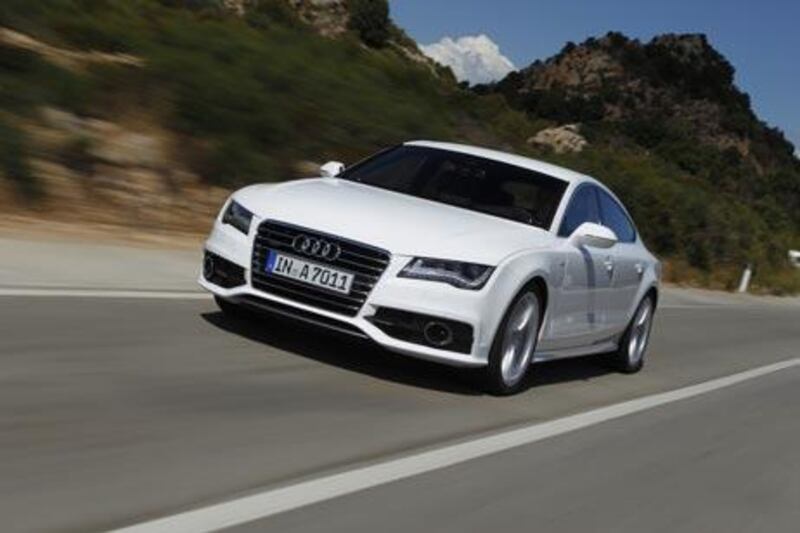Audi has made a fortune marching boldly into territory where no other car maker dares to go. It was the first to put a diesel engine into a convertible sports car (the TT), it found a tiny hole to squeeze in a whole new range (the A5), it stretched the top end with the R8 and now it's going electric with sports cars. But the trouble with walking through minefields is that sooner or later something will explode in your face.
Rivals have been hoping for an Audi misstep, but so far, it hasn't really come. And with the A7, Audi's found another niche to fill. The five-door hatchback - it's not a coupe - has been built to entice a mysterious band of mostly male buyers for whom an A6 is too stodgy, an A6 wagon is too family, a Q7 is too tall and an A8 is too corporate. It's a conflation of all the talents of those other cars, and you could simultaneously admire its abilities and deride its necessity.
Certainly, it's a mixed bag in terms of design, where it serves, according to Audi Group design boss, Wolfgang Egger, to demonstrate where Audi's heading. From angles such as the front three quarter and the pure profile, it looks superb, while from other angles it looks, well, ungainly. The much-vaunted "kamm" tail might be true to the 2009 Detroit Motor Show concept, but visually drags the car's backside too low, while its pop-up rear wing is so small that it looks, when deployed, like it's come straight off a TT and doesn't fit with the size of the A7.
Even so, there's a lot to like, including the new modular chassis that will also sit inside next year's A6. That car will outsell this one by about five to one, so the A7's underpinnings are almost the most important thing about it. The chassis is at least 20 per cent aluminium and what steel there is seems to all have patents attached to it. For the transition zones between the engine bay and the cabin, the floor cross braces and A-pillars, they use steel that is fed through a furnace at almost 1,000°F before it's shaped. A sliver of this 30mm wide and two millimetres thick is strong enough to hang five A7s without bending.
One of the most important things beneath the curvy Audi aluminium and steel is that the engine sits lengthways in the engine bay, rather than across it. Like its BMW and Mercedes rivals, it's a huge step forward for ride and handling. Longitudinal engines sit on top of the axle line, rather than in front of it, which lends itself to better dynamics. A longitudinal engine can eat into the cabin space, but Audi engineers shortened the length of the dashboard to keep the interior size. The A7 can fit four full-sized adults and a week's worth of luggage.
The rear headroom is compromised, but not by as much as you'd think by looking at the swoop of the roof line. Legroom is terrific - far more than you get in BMW's new 5 Series - and the interior has taken plenty of ideas from the new A8 limousine. There is a system that turns a 3G signal into a full wireless internet hotspot with Google Earth taking care of the layouts of the satellite navigation.
One of the issues with the cabin, gorgeously driver-oriented as it is, is that you'll pay extra for the fruitier options, including the internet hotspot. But there's more: head-up display, plenty of seating and interior trim options, infra-red night vision screens, push-button parallel parking, and a system that ties the satnav into the steering and skid control systems to give a heads-up that the car is entering tricky territory.
But you'll find out quickly enough whether you've made the right choice on the engines. There is an "eight-speed" Multitronic transmission that sits behind the engines on the front-drive cars and, while there are eight sort-of steps, they're artificially induced, because the transmission is a CVT (continuously variable transmission) and it helps pull down the fuel economy. Most people will plump for the 3.0L, direct-injection, supercharged V6, which works best with the Quattro all-wheel drive and the seven-speed double-clutch gearbox.
It's an engine that gives out 300hp of power, but does its best work down in the middle of its range, where it punches out 440Nm of torque. It sprints pretty well, too, hitting 100kph in 5.6 seconds, and it averages 8.2L/100km in combined fuel consumption. Then there's Audi's Drive Select System, which when combined with (optional) air suspension, shifts the gear-change points, the throttle response and the steering feedback to make the car exactly how you prefer it for whatever you're doing.
It will draw criticism in its Comfort and Automatic settings, because around town and at low speeds, the steering is very, very light. Yet, for a lot of driving situations, that's relaxing. If you switch across to Sport, you'll find a heavier steering to show off just how much grip and poise this new chassis has to offer. And there's plenty of that. In its Quattro all-wheel-drive format, it's astonishingly grippy - and comfortable. It never feels like it's even remotely strained by anything the road throws at it or any sudden circumstances throw up.
The issue could come with the optional S Line suspension system, which lowers the car 20mm on its suspension and stiffens the ride. In standard form, the A7 is a wonderfully composed operator. It just needs to find a way to dig up the buyers who understand all of that. Audi Middle East expects the A7 to reach the UAE in the first quarter of next year. No prices have yet been set.






